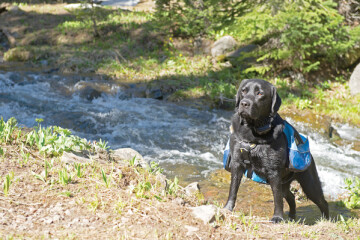Dog on Board: Traveling with Fido
As another school year draws to a close and the summer months approach, families are preparing for road trips to enjoy the outdoors, visit relatives, or explore new places. Often, the family dog is included. If you are planning a long road trip with your dog this summer, taking a few simple steps to prepare him for the adventure will make the outing safer and more enjoyable for everyone.
Although it is easy to acclimate puppies to long car rides, some newly adopted adult dogs may not have had the life experiences necessary to be relaxed and comfortable in a vehicle. Carolyn Murray, owner of The Canny Canine Dog Training in Bozeman, points out that it is important to take the time and work through the steps necessary to help your dog be comfortable and safe during extended trips. “This should be one of the first things you focus on when an adult dog is acquired,” she said. The first step is to help your dog to feel comfortable just being around a parked car. “Let the dog relax and feed him some yummy treats. Talk in a calm, happy voice to reassure the dog without over stimulating him. Start creating a positive association with the car,” Murray suggests.
Once the dog is at ease in and around the parked vehicle, begin taking short trips and gradually increase the amount of time the dog is expected to be in the car. Also, owners often make the mistake of limiting a dog’s time in the car exclusively for trips to the veterinarian. “Car rides resulting in a positive life experience like a hike, a run, or a play date are great ways to teach your dog how to enjoy traveling in a vehicle,” Murray adds. “Overall, your goal is to make your dog comfortable spending increasingly longer periods of time in your car.”
During the first several rides, also be sensitive to other factors that may contribute to your dog’s anxiety such as loud music or open windows. At high speeds, the sound and physical sensation of wind rushing into the car can add to your dog’s nervousness. Try to minimize these distractions.
There are some additional remedies to consider for overly anxious dogs. “Consult a qualified trainer to begin a counter-conditioning program,” Murray suggests. “Also, some people swear by Bach’s Rescue Remedy to help calm dogs. Others prefer to use pheromones Dog Appeasing Pheromone or DAP. If you’ve tried everything and your dog is not responding, it is definitely time to consult your veterinarian for help. The idea of sedation is not taken lightly by any animal professional and not something with which a dog owner should experiment,” she emphasizes.
A cautionary note about travel during the summer months: plan your trips carefully during hot days, especially if they involve errands during which your dog will be left in the car. On an 80-degree day, the temperature inside a car—even with all of the windows cracked a few inches—can climb to over 100 degrees in just a matter of minutes. Dogs can quickly begin to suffer from the effects of heat exhaustion or heatstroke, which can be fatal.
As you plan the specifics of your trip, take the time to research your route for places to stop to allow your dog a rest break. For example, when we travel with our dog, Emma, we look ahead to some of the cities we will be passing through to see if they offer dog-friendly parks where she can get out and stretch her legs a bit. Also, many rest stops along the highways include a grassy area designated as a place where dogs can potty and rest. Each individual dog is different, but be aware of your own dog’s limitations as to how long he is comfortable and relaxed in the car before showing signs of needing a break. During our road trips with Emma, we attempt to stop every two to three hours, at minimum.
If your travels require an overnight stop, be sure to call ahead and inquire about the hotel’s pet policy. There are many hotels that allow dogs, but may charge an additional small fee per day. For restaurants, we try to find places that allow dogs in their outside seating area. AAA publishes a comprehensive guide that includes more than 15,000 AAA-approved hotels, restaurants, campgrounds and attractions nationwide that welcome dogs: http://www.aaa.com/petbook/.
How best to transport your dog in a vehicle? According to Murray, dogs that are crated during travel are by far the safest: “If you have the room, I certainly encourage crating your dog as it is hands down the safest way to travel with your pet.” If dogs are not secured, they can become seriously injured during an accident—and have been known to run from the scene and become lost and separated from their family. Heavy-duty crates are available, and can help reduce the chance of serious injury during a collision. As an additional safety measure, securely fasten the crate to the car itself so that it remains in place during impact. Dogs may need training to acclimate them to being in a crate if they have not been trained to use one already.
It isn’t always practical to use a crate, however. “With a Subaru wagon and two large dogs, crates have never been an option for me,” Murray says. “I try to make the back seat as comfortable as possible for them. I also purchased padded harnesses made for clipping into seat belts to make sure everyone remains in the back seat while traveling highway speeds.” Securing a dog during a car ride prevents him from being a possible distraction to the driver, and keeps him away from potentially deployed airbags, which can cause serious injury.
Always be sure that your dog is wearing proper identification and is micro chipped during your travels. Also, be sure to include a water bowl, plenty of fresh water, a first aid kit, and any special food or medication for your dog when packing for your trip.
If your family is anything like mine, going on a road trip and leaving your dog behind isn’t really an option. Taking the time to properly acclimate your dog to long car rides can make your trip that much more enjoyable and stress-free. If your dog suffers from anxiety even during short rides, take the time to seek assistance from a professional to help modify his reactions to being in a vehicle.
For help with crate-training, acclimating dogs to vehicles, or any other behavioral issues you may be experiencing with your pup, Carolyn Murray can be reached via her website: http://www.thecannycanine.com/
Photo credit: Canine Pixel Dog Photography

